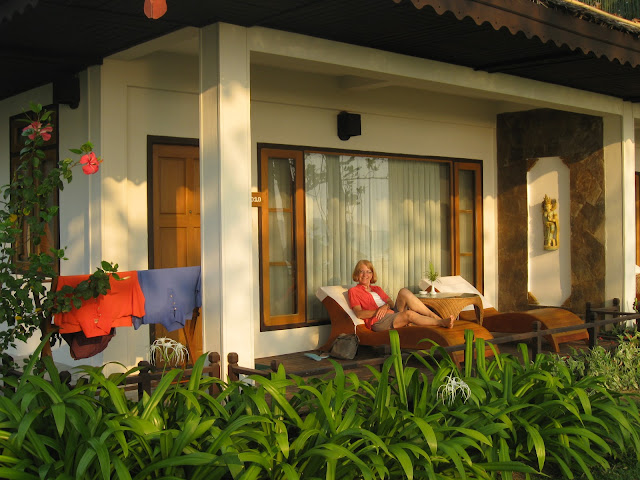Burmese cuisine seems to be largely mild curries – chicken, pork, beef – usually served with a variety of side dishes, some rice, a bowl of light soup – lentil or vegetable -
and various small dishes of condiments – garlic in soy sauce, chilli flakes, a gingery lemony sauce. The problem we have with it is that they seem to make the curries in large batches in the morning and then put it out on a counter and serve from it for the rest of the day. At lunchtime it may still be warm but later in the day it’s at room temperature – and just sitting there. And maybe the unused portion from yesterday has been added to the pot
- so we really didn’t fancy it much. We did try it a couple of times early on – and we found that the meat used wasn’t the greatest – lots of bone and gristle – so we decided to move on to other things.
Happily Chinese and Thai food is usually on offer alongside local dishes and this is usual prepared fresh and served hot so we have eaten quite well. Lots of fresh vegetables – steamed or stir fried.
There’s usually fish on the menus, either grilled or in curries, but transportation is poor so away from the sea it’s usually lake or river fish. We both find that a bit muddy-tasting so tend to avoid it.
A couple of other things we liked were both salads, one from grated green (presumably unripe ?) papaya with chopped peanuts and a citrus/chilli dressing, and the other from pickled tea leaves again with nuts and a spicy dressing.
There was usually some lovely fresh fruit with breakfast – juicy and sweet watermelon, the best papaya we’ve ever tasted, a delicately flavoured pineapple – quite different from the strong tasting ones from central America, and small but intensely flavoured bananas. We also saw mango trees but the fruit was never on offer – perhaps they’re out of season.
But when we got to Ngapali beach we pigged out on seafood – huge tiger prawns, squid, red snapper etc. It’s been the best food of the trip – a simple restaurant on the beach, toes in the sand, with a plate of grilled tiger prawns, some red snapper fillet, a beautifully dressed avocado and tomato salad and a plate of steamed vegetables delicately flavoured with ginger and lemongrass – yours for about £8 for two.
Add another £12 if you want a chilled bottle of Red Mountain Sauvignon Blanc from near Inle Lake. We did.
And that was after watching the sun go down from the next door beach bar with a couple of mojitos and a couple of rum sours - £3 the lot during happy hour. It’s very inexpensive to live well here.





















































